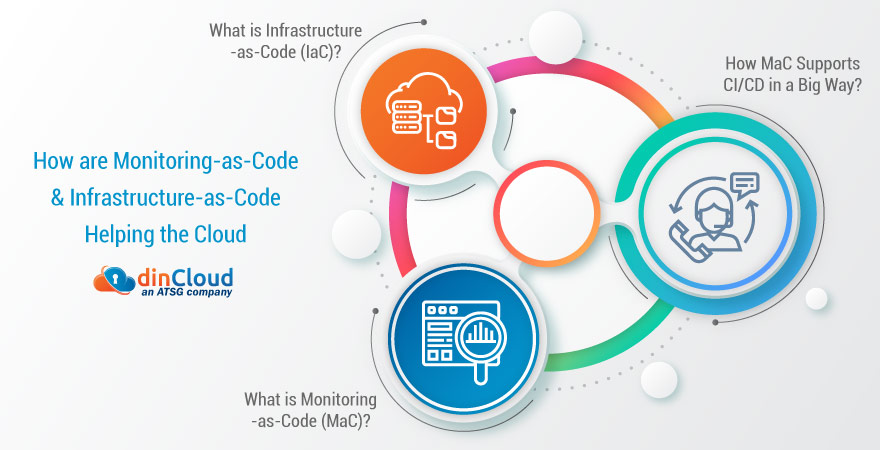Enterprises have started embracing Cloud Computing in a whole new light. In the present day and age, we are moving away from the traditional “lift and shift” approach towards adopting cloud infrastructures.
The enterprise world is now moving towards a “cloud native” approach. What this means is that now, enterprise workloads and applications will not be retro-fitted to cloud infrastructures. Instead, they will be built for the Cloud, from the ground-up.

Related: The Ingredients of a Fruitful Digital Transformation
However, all this is easier said than done. Most enterprises and businesses adopt cloud infrastructures under strict timelines. In certain cases, cloud migrations are the result of some external factor, such as a global pandemic, and things have to move even quicker.
So, the solution to these bottlenecks and issues lies in two emerging technologies, namely Monitoring-as-Code (MaC) and Infrastructure-as-Code (IaC). Both these technologies work in tandem to monitor, as well as manage cloud native systems quite seamlessly.
In this post, we will touch upon both these emerging technologies, and also highlight how they are taking us one step closer towards a full on cloud native ecosystem.
Related: How Should Business Leaders Approach Digital Transformation?
What is Infrastructure-as-Code (IaC)?
In the case of most cloud computing driven technologies, we have to deal with virtualized IT resources that include, but are not limited to storage, network and compute. The hardware layer generally remains limited to the data center.
The entire focus of IaC is on the virtualized, or software defined layer of cloud based services, applications and solutions. This gives the development and monitoring teams full visibility into source code files that make all cloud operations possible.
So, there are two core aspects of IaC, which are monitoring the software defined or virtualized layer of the cloud service, and also optimizing the existing codes to extract that last ounce of performance from the limited cloud resources available on hand.
What is Monitoring-as-Code (MaC)?
The concept of MaC is in fact an extension of the Infrastructure-as-Code (IaC) concept that we have just discussed. In the present business environment, cloud infrastructures are doing most of the heavy lifting when it comes to mission critical workloads and processes.
So, it becomes absolutely critical that all the underlying processes that are responsible for executing cloud workloads are not only in perfect sync within themselves, but are also interacting with the other processes within the ecosystem in a seamless manner.
The capabilities of MaC are not just limited to existing, already commissioned cloud native processes. Instead, MaC is playing a leading role in the process of streamlining and optimizing the development processes for cloud native applications.
Slowly but surely, we are pivoting away from the traditional approach towards software and application development, in which bugs and inconsistencies come to light at a very advanced stage of development.
Related: Cloud and Edge Based Virtual Power Plants (VPPs) – The Future
In some extreme cases, such inconsistences are highlighted even after elevating an application to the test phase, or its formal commissioning. This can have serious ramifications for businesses that are now relying on the Cloud more than ever.
How MaC Supports CI/CD in a Big Way?
Monitoring-as-Code (MaC) is also playing a very instrumental role towards the concepts of Continuous Integration (CI) and Continuous Delivery (CD). With its ability to identify coding related inconsistencies at the very development stage, developers can achieve CI/CD.
This in turn greatly reduces the whole software development life-cycle, which is a key performance indicator (KPI) when enterprises want to measure how efficiently were they able to achieve cloud adoption, and full cloud native integration.
Related: How are Cloud Solutions a Key Enabler for Business Mobility?
Conclusion
At the end of the day, the ultimate beneficiary of emerging technologies like Monitoring-as-Code (MaC) and Infrastructure-as-Code (IaC) is the end user or consumer. With little to no concern about what all happens in the backdrop, the consumer wants a wow factor.
Emerging technologies like MaC and IaC are putting businesses in the right “zone”, the one in which they can roll out innovative new solutions to woo today’s tech dependent and savvy customers. Consumer success will ultimately translate into more revenues.
Interested in cloud services for your enterprise, Why not Request a Demo of dinCloud’s best-in-class solutions for a more hands-on experience!


